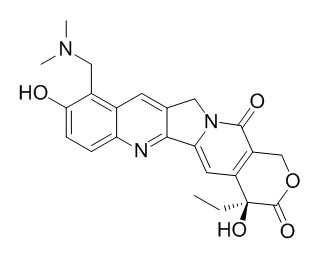Topotecan
TLyp-1-functionalized topotecan-loaded niosomes could significantly improve anti-glioma treatment. Preparation of topotecan into a temperature-sensitive phase-change hydrogel achieves a long-term sustained antitumor effect on Rb cells, and may be a useful strategy for the treatment of intraocular Rb.
Inquire / Order:
manager@chemfaces.com
Technical Inquiries:
service@chemfaces.com
Tel:
+86-27-84237783
Fax:
+86-27-84254680
Address:
1 Building, No. 83, CheCheng Rd., Wuhan Economic and Technological Development Zone, Wuhan, Hubei 430056, PRC
Providing storage is as stated on the product vial and the vial is kept tightly sealed, the product can be stored for up to
24 months(2-8C).
Wherever possible, you should prepare and use solutions on the same day. However, if you need to make up stock solutions in advance, we recommend that you store the solution as aliquots in tightly sealed vials at -20C. Generally, these will be useable for up to two weeks. Before use, and prior to opening the vial we recommend that you allow your product to equilibrate to room temperature for at least 1 hour.
Need more advice on solubility, usage and handling? Please email to: service@chemfaces.com
The packaging of the product may have turned upside down during transportation, resulting in the natural compounds adhering to the neck or cap of the vial. take the vial out of its packaging and gently shake to let the compounds fall to the bottom of the vial. for liquid products, centrifuge at 200-500 RPM to gather the liquid at the bottom of the vial. try to avoid loss or contamination during handling.
J of Physics Conference Series2019, 1349(1)
Phytochemistry.2017, 141:162-170
Pathol Res Pract.2024, :260:155445.
J Nat Prod.2019, 82(4):1002-1008
Oxid Med Cell Longev.2022, 2022:5888636.
Histol Histopathol.2022, 18518.
Nature Ecology & Evolution2020, doi: 10.1038
Appl. Sci.2022, 12(4), 2032.
Korean J of Food Science&Technology 2017, 49(2):146-150
Molecules.2022, 27(22):7887.
Related and Featured Products
Onco Targets Ther. 2019 Jul 30;12:6069-6082.
A temperature-sensitive phase-change hydrogel of topotecan achieves a long-term sustained antitumor effect on retinoblastoma cells.[Pubmed:
31534347 ]
Retinoblastoma (Rb) is one of the most common malignancies among children. Following early diagnosis and prompt treatment, the clinical outcome or prognosis of Rb is promising. However, the prognosis or survival rates of patients with late-stage Rb remain poor. Current therapeutic strategies for advanced Rb mainly involve the use of advanced chemotherapeutic options. However, the efficacy of these strategies is not satisfactory. Therefore, the development of novel strategies to achieve a more effective antitumor effect on late-stage Rb is of crucial importance.
METHODS AND RESULTS:
Topotecan was dissolved in phosphate-buffered saline and prepared into a temperature-sensitive phase-change hydrogel (termed Topo-Gel). Moreover, Topo-Gel was injected into tumor tissues formed by Y79 cells (an Rb cell line) in nude mice to examine the long-term release and long-acting antitumor effect of Topo-Gel on Rb tumors.
Topo-Gel transforms from liquid to a hydrogel at near body temperatures (phase-change temperature [T1/2] was 37.23±0.473 °C), and maintains the slow release of Topotecan in Rb tumor tissues. Following the subcutaneous injection of Topo-Gel, the treatment induced long-acting inhibition of tumor growth and relieved the adverse effects associated with Topotecan. Topo-Gel, a temperature-sensitive phase-change hydrogel, is a slow-release system that prolongs the presence of Topotecan in Rb tissues, and preserves the efficacy of Topotecan in the long term.
CONCLUSIONS:
Preparation of Topotecan into a temperature-sensitive phase-change hydrogel achieves a long-term sustained antitumor effect on Rb cells, and may be a useful strategy for the treatment of intraocular Rb.
Int J Mol Sci. 2019 Sep 22;20(19). pii: E4696.
Rapid Microfluidic Preparation of Niosomes for Targeted Drug Delivery.[Pubmed:
31546717 ]
Niosomes are non-ionic surfactant-based vesicles with high promise for drug delivery applications. They can be rapidly prepared via microfluidics, allowing their reproducible production without the need of a subsequent size reduction step, by controlled mixing of two miscible phases of an organic (lipids dissolved in alcohol) and an aqueous solution in a microchannel. The control of niosome properties and the implementation of more complex functions, however, thus far are largely unknown for this method.
METHODS AND RESULTS:
Here we investigate microfluidics-based manufacturing of Topotecan (TPT)-loaded polyethylene glycolated niosomes (PEGNIO). The flow rate ratio of the organic and aqueous phases was varied and optimized. Furthermore, the surface of TPT-loaded PEGNIO was modified with a tumor homing and penetrating peptide (tLyp-1). The designed nanoparticular drug delivery system composed of PEGNIO-TPT-tLyp-1 was fabricated for the first time via microfluidics in this study. The physicochemical properties were determined through dynamic light scattering (DLS) and zeta potential analysis. In vitro studies of the obtained formulations were performed on human glioblastoma (U87) cells.
CONCLUSIONS:
The results clearly indicated that tLyp-1-functionalized TPT-loaded niosomes could significantly improve anti-glioma treatment.
6-Hydroxywogonin
Catalog No: CFN95009
CAS No: 76844-70-7
Price: $368/5mg
Asiaticoside B
Catalog No: CFN95124
CAS No: 125265-68-1
Price: $158/20mg
Emodin-8-O-beta-gentiobioside
Catalog No: CFN95132
CAS No: 66466-22-6
Price: $368/5mg
Complanatoside C
Catalog No: CFN95144
CAS No: N/A
Price: $318/5mg
[(1(10)E,2R,4R)]-2-Methoxy-8,12-epoxygemacra-1(10),7,11-trien-6-one
Catalog No: CFN95198
CAS No: 75412-95-2
Price: $318/10mg
Isovalerylshikonin
Catalog No: CFN95222
CAS No: 52387-14-1
Price: $318/10mg
Arganine B
Catalog No: CFN95281
CAS No: 144425-21-8
Price: $318/5mg
Eschweilenol C
Catalog No: CFN95363
CAS No: 211371-02-7
Price: $318/10mg
4'-Hydroxy-5,7,3'-trimethoxyflavone
Catalog No: CFN95398
CAS No: 1239-68-5
Price: $318/5mg
(2S)-5,7,3',4'-tetramethoxyflavanone
Catalog No: CFN95406
CAS No: 74628-43-6
Price: $318/10mg



